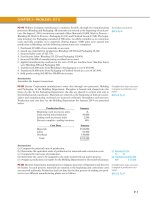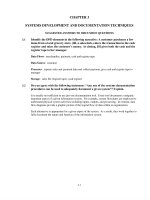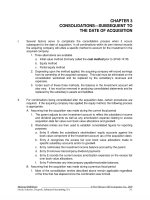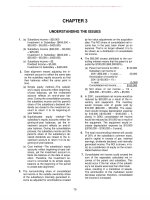Ch03 hullofod8 thedition
Bạn đang xem bản rút gọn của tài liệu. Xem và tải ngay bản đầy đủ của tài liệu tại đây (486.49 KB, 18 trang )
Chapter 3
Hedging Strategies Using
Futures
Options, Futures, and Other Derivatives, 8th Edition,
Copyright © John C. Hull 2012
1
Long & Short Hedges
A long futures hedge is appropriate when
you know you will purchase an asset in
the future and want to lock in the price
A short futures hedge is appropriate
when you know you will sell an asset in
the future and want to lock in the price
Options, Futures, and Other Derivatives, 8th Edition,
Copyright © John C. Hull 2012
2
Arguments in Favor of Hedging
Companies should focus on the main
business they are in and take steps to
minimize risks arising from interest rates,
exchange rates, and other market variables
Options, Futures, and Other Derivatives, 8th Edition,
Copyright © John C. Hull 2012
3
Arguments against Hedging
Shareholders are usually well diversified and
can make their own hedging decisions
It may increase risk to hedge when
competitors do not
Explaining a situation where there is a loss on
the hedge and a gain on the underlying can
be difficult
Options, Futures, and Other Derivatives, 8th Edition,
Copyright © John C. Hull 2012
4
Basis Risk
Basis is usually defined as the spot
price minus the futures price
Basis risk arises because of the
uncertainty about the basis when
the hedge is closed out
Options, Futures, and Other Derivatives, 8th Edition,
Copyright © John C. Hull 2012
5
Long Hedge for Purchase of an Asset
Define
F1 : Futures price at time hedge is set up
F2 : Futures price at time asset is purchased
S2 : Asset price at time of purchase
b2 : Basis at time of purchase
Cost of asset
S2
Gain on Futures
F2 −F1
Net amount paid
S2 − (F2 −F1) =F1 + b2
Options, Futures, and Other Derivatives, 8th Edition,
Copyright © John C. Hull 2012
6
Short Hedge for Sale of an Asset
Define
F1 :
F2 :
S2 :
b2 :
Futures price at time hedge is set up
Futures price at time asset is sold
Asset price at time of sale
Basis at time of sale
Price of asset
S2
Gain on Futures
F1 −F2
Net amount received
S2 + (F1 −F2) =F1 + b2
Options, Futures, and Other Derivatives, 8th Edition,
Copyright © John C. Hull 2012
7
Choice of Contract
Choose a delivery month that is as close as
possible to, but later than, the end of the life
of the hedge
When there is no futures contract on the
asset being hedged, choose the contract
whose futures price is most highly correlated
with the asset price. This is known as cross
hedging.
Options, Futures, and Other Derivatives, 8th Edition,
Copyright © John C. Hull 2012
8
Optimal Hedge Ratio (page 57)
Proportion of the exposure that should optimally be
hedged is
sS
*
h r
sF
where
sS is the standard deviation of DS, the change in the
spot price during the hedging period,
sF is the standard deviation of DF, the change in the
futures price during the hedging period
r is the coefficient of correlation between DS and DF.
Options, Futures, and Other Derivatives, 8th Edition,
Copyright © John C. Hull 2012
9
Optimal Number of Contracts
QA
Size of position being hedged (units)
QF
Size of one futures contract (units)
VA
Value of position being hedged (=spot price time QA)
VF
Value of one futures contract (=futures price times QF)
Optimal number of contracts if
no tailing adjustment
h *Q A
QF
Optimal number of contracts
after tailing adjustment to allow
or daily settlement of futures
h *V A
VF
Options, Futures, and Other Derivatives, 8th Edition,
Copyright © John C. Hull 2012
10
Example (Pages 59-60)
Airline will purchase 2 million gallons of jet
fuel in one month and hedges using heating
oil futures
From historical data sF =0.0313, sS =0.0263,
and r= 0.928
0.0263
h 0.928
0.7777
0.0313
*
Options, Futures, and Other Derivatives, 8th Edition,
Copyright © John C. Hull 2012
11
Example continued
The size of one heating oil contract is 42,000 gallons
The spot price is 1.94 and the futures price is 1.99
(both dollars per gallon) so that
V A 1.94 2,000,000 3,880,000
V F 1.99 42,000 83,580
Optimal number of contracts assuming no daily
settlement 0.7777 2,000,000 42,000 37.03
Optimal number of contracts after tailing
0.7777 3,880,000 83,580 36.10
Options, Futures, and Other Derivatives, 8th Edition,
Copyright © John C. Hull 2012
12
Hedging Using Index Futures
(Page 61)
To hedge the risk in a portfolio the
number of contracts that should be
shorted is V A
b
VF
where VA is the value of the portfolio, b
is its beta, and VF is the value of one
futures contract
Options, Futures, and Other Derivatives, 8th Edition,
Copyright © John C. Hull 2012
13
Example
S&P 500 futures price is 1,000
Value of Portfolio is $5 million
Beta of portfolio is 1.5
What position in futures contracts on the S&P
500 is necessary to hedge the portfolio?
Options, Futures, and Other Derivatives, 8th Edition,
Copyright © John C. Hull 2012
14
Changing Beta
What position is necessary to reduce
the beta of the portfolio to 0.75?
What position is necessary to increase
the beta of the portfolio to 2.0?
Options, Futures, and Other Derivatives, 8th Edition,
Copyright © John C. Hull 2012
15
Why Hedge Equity Returns
May want to be out of the market for a while.
Hedging avoids the costs of selling and
repurchasing the portfolio
Suppose stocks in your portfolio have an
average beta of 1.0, but you feel they have
been chosen well and will outperform the
market in both good and bad times. Hedging
ensures that the return you earn is the riskfree return plus the excess return of your
portfolio over the market.
Options, Futures, and Other Derivatives, 8th Edition,
Copyright © John C. Hull 2012
16
Stack and Roll (page 65-66)
We can roll futures contracts forward to
hedge future exposures
Initially we enter into futures contracts to
hedge exposures up to a time horizon
Just before maturity we close them out an
replace them with new contract reflect the
new exposure
etc
Options, Futures, and Other Derivatives, 8th Edition,
Copyright © John C. Hull 2012
17
Liquidity Issues (See Business Snapshot 3.2)
In any hedging situation there is a danger that
losses will be realized on the hedge while the
gains on the underlying exposure are
unrealized
This can create liquidity problems
One example is Metallgesellschaft which sold
long term fixed-price contracts on heating oil
and gasoline and hedged using stack and roll
The price of oil fell.....
Options, Futures, and Other Derivatives, 8th Edition,
Copyright © John C. Hull 2012
18









